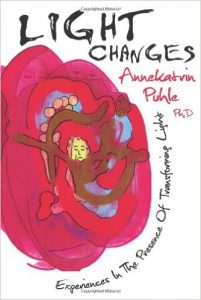 Light Changes: Experiences in the Presence of Transforming Light – by Annekatrin Puhle PhD
Light Changes: Experiences in the Presence of Transforming Light – by Annekatrin Puhle PhD
Reviewed by David Lorimer
Subtitled ‘Experiences in the Presence of Transforming Light’, this collection of over 800 cases spanning more than 100 years of research makes fascinating reading and opens up new vistas on the many dimensions of human existence, especially in relation to death. Unusual light phenomena have been documented for centuries in religion and mysticism and it is interesting to learn that there are 2,746 references to angels in the Bible – about a third of the cases here involve angelic beings. The author distinguishes 21 light forms in her phenomenological analysis, all of which are illustrated in the representative case histories. Many of these are from existing literature but there are also some cases directly reported to the author.
Following a discussion of the case collection, the book moves on to consider the percipients, the phenomena and the meaning attributed to these experiences. The bulk of the book is devoted to eight main classifications of cases, which are then presented and discussed. A number of striking cases involve angels protecting people in dangerous situations and 16% report information conveyed unknown to the percipient. Tommy was abducted and murdered in a hit and run incident, following which his family received a message about where he was killed and the fact that they would still find his blood there if they hurried. They went to the place specified and indeed found blood. A further sequence of messages enabled the police to track down and convict the killer. In another case a girl’s grandmother died and appeared to her in a dream to tell her where she had hidden her Christmas present at the bottom of a box. These kinds of cases can potentially be ascribed to Super-ESP but they contain a sense of agency which in my view makes such an explanation unlikely. Light is sometimes seen around dying people, and the dead can appear in forms of light to reassure their loved ones that they are OK. Saints are often seen with light seemingly emanating from their bodies. Reading the cases as a whole indicates that our physical existence is interwoven with other usually invisible orders of being.
Puhle devotes the last part of the book to exploring the significance of the case histories. She distinguishes between six antecedent variables or variations of light experiences and a further six consequent variables about the meaning of the experiences including comfort and impact. She then analyses these 12 factors in terms of their occurrence, which shows a prevalence of meaning in 91% of cases, an experience of a light form in 76% and a sense of comfort in 58% followed by impact at 42%. The first-hand cases also reflect this relative prevalence of factors. In summary, Puhle observes that ‘light thus works as a connecting link to the source of life, to life energy, and unlimited love. It creates an inner and outer balance, and fills or envelopes its protégé with harmony and peace.’ This concluding observation is consistent with many other sources, including the recent popular books by Anita Moorjani and Eben Alexander. This is nicely rounded off with a quotation from the theologian Hans Kung – who has himself investigated such experiences – that he expects to die into the light. This spiritual message could not be more important at a time when the violence in the world seems to become more intense and demands of spiritual people a response nevertheless affirming the primacy of love, as revealed in this extensive collection of cases. As Pitirim Sorokin observed around 1920 when he was imprisoned by both sides in St Petersburg, violence only ever calls forth answering violence, so we are challenged to insist that love still calls forth love. We can also remember Whiteheads’ remark that the instability of evil is the moral order of the world.
